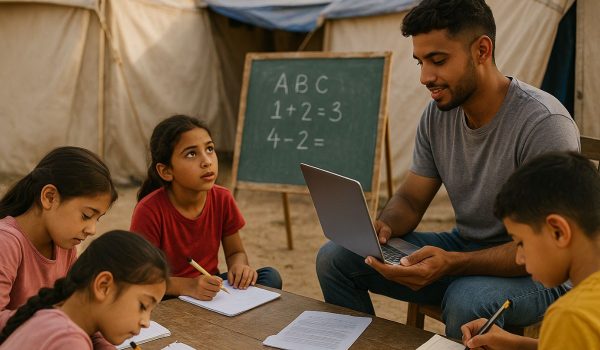Life in a refugee camp is filled with challenges. From limited resources to constant uncertainty, everyday survival takes effort. But even in these difficult conditions, there’s hope—and much of it comes from the people themselves. Peer education is one of the most meaningful ways that hope is shared and knowledge is passed on.
Peer education means people teaching each other. In refugee camps, this often looks like youth mentoring youth, mothers sharing health tips, or teens helping classmates understand lessons. It doesn’t require large classrooms or professional degrees. What it needs most is trust, connection, and the will to help one another grow.
Why Peer Education Matters in Refugee Camps
This article highlights how peer-led education creates powerful change in refugee communities. It covers:
- How refugee youth are stepping up as leaders and teachers
- What makes peer education successful in resource-limited settings
- The long-term value of learning from someone who shares your experience
Learning Together, Growing Together
In many refugee camps, formal education is hard to access. Schools may be overcrowded or underfunded. Sometimes, there are no schools at all. But learning doesn’t stop just because a classroom is missing. In these settings, peer education becomes a lifeline.
Young people begin teaching one another in small groups. A teenager who learned basic math might hold short lessons for others. A girl who attended health workshops may help younger children learn about hygiene. These moments of shared learning happen in tents, under trees, or during walks through the camp.
Peer education thrives because it’s based on shared experiences. Refugees often face similar struggles, so they can relate to each other in ways outsiders might not. This connection builds trust, which is a key part of learning.
Building Confidence and Leadership
One of the strongest parts of peer education is how it builds confidence. When someone becomes a teacher, even in a small way, they see themselves differently. They are no longer just receiving help—they are giving it. This sense of purpose can make a big difference in places where people often feel powerless.
Youth leaders often emerge through these programs. They may begin by leading small sessions and then take on more responsibility. Over time, they become trusted voices in their community. They help younger children, organize discussions, or share lessons on topics like safety, health, or even art.
These new roles help young people see their potential. Even without a formal school, they are developing skills that can shape their future.
Topics That Matter Most
Peer education in refugee camps focuses on the needs of the community. That means topics can vary, but many revolve around health, safety, and personal growth. Teens often lead sessions on topics like hygiene, mental health, or conflict resolution. Others may teach reading and writing to younger children.
There are also programs where youth discuss sensitive topics—such as early marriage, gender-based violence, or coping with trauma. Because these subjects can be difficult, hearing them from a peer can make them easier to talk about.
These programs help create safe spaces where people feel heard. They also give participants the tools to make informed choices and support one another. By fostering trust and mutual respect, these discussions empower youth to break the silence around taboo issues, challenge harmful norms, and build a culture of empathy and accountability within their communities.
Women and Girls Leading the Way
In many camps, young women and girls are leading peer education efforts. They form groups to teach younger girls about health, rights, and leadership. These spaces allow girls to speak freely and support one another.
For many girls who have lost access to school, this kind of peer learning becomes their main form of education. It keeps them engaged and helps protect them from risks like early marriage or exploitation.
By becoming educators themselves, girls show others that their voices matter. They become role models in communities that often see them as vulnerable. Their leadership sends a strong message: knowledge is powerful, and anyone can share it.
Challenges and Creative Solutions
Running peer education programs in refugee camps is not always easy. There are often limited materials, no permanent space, and few formal resources. But people get creative. They use recycled notebooks, draw on the ground with sticks, or use songs to teach lessons.
Support from local NGOs can help. Some provide training, safe spaces, or basic materials. But much of the strength still comes from within the community. Refugees support each other, learn together, and grow through shared experience.
Programs that succeed often keep things simple. They focus on connection and care, rather than structure. They trust that people, especially youth, know how to lead when given the chance.
The Power of Belonging
Peer education does more than teach facts. It builds a sense of belonging. Refugee camps can be isolating, but peer-led groups offer a place to feel seen and valued. Participants often speak of feeling more hopeful and connected after joining.
These programs also build community resilience. When people teach each other, they build networks of care. They share resources, watch out for one another, and take pride in growing together. That sense of connection is one of the strongest protections a person can have in hard times.
Peer education in refugee camps shows what’s possible when people come together. With little more than trust and the will to learn, they create change. These programs remind us that even without buildings, funding, or formal lessons, communities can still teach, grow, and thrive.

